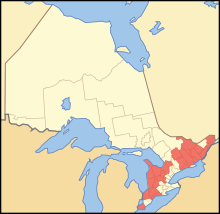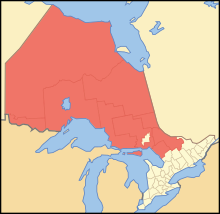Administrative division of Ontario
The administrative structure of Ontario is diverse. There are 445 parishes that are structured in four different ways. The difference lies in the amount of public services that are offered.
The different structures of local and regional government in Ontario are complex and are the result of approaches used at different times by provincial governments to adequately address the different needs of individual areas. Due to the large inequalities between the individual regions, it would be difficult to apply a uniform administrative structure across the province.
Single-tier communities
A single-tier municipality is governed by a single municipal administration. It is subordinate to neither a county nor a regional government and has no other units under it. A single-tier municipality is either a former regional municipality or was previously a county whose municipalities were merged into a single administrative unit in the 1990s. In addition, all municipalities in northwestern Ontario (that is, all municipalities within districts) are single-tier municipalities by definition. A subtype of stage community is separated community (separated municipality) .
There are the following single-level municipalities that are not within a district:
- Municipality of Chatham-Kent , formerly Kent County
- City of Greater Sudbury , formerly Regional Municipality of Sudbury
- Haldimand County , formerly Regional Municipality of Haldimand-Norfolk
- City of Hamilton , formerly Hamilton-Wentworth Regional Municipality
- City of Kawartha Lakes , formerly Victoria County
- Norfolk County , formerly the Regional Municipality of Haldimand-Norfolk
- City of Ottawa , formerly Regional Municipality of Ottawa-Carleton
- Prince Edward County
- County of Brant
- City of Brantford
- City of Toronto , formerly Metropolitan Toronto
Separated communities
Separated municipalities ( separated municipalities ) are administratively independent of the surrounding county. Unlike single-tier parishes, however, they are counted statistically in the county. Often times, the county government is in a detached parish when the county has no other major cities.
The following separate communities exist (with surrounding counties):
- Barrie ( Simcoe County )
- Belleville ( Hastings County )
- Brockville ( Leeds and Grenville United Counties )
- Gananoque ( Leeds and Grenville United Counties )
- Guelph ( Wellington County )
- Kingston ( Frontenac County )
- London ( Middlesex County )
- Orillia ( Simcoe County )
- Pembroke ( Renfrew County )
- Peterborough ( Peterborough County )
- Prescott ( Leeds and Grenville United Counties )
- Quinte West ( Hastings County )
- Smiths Falls ( Lanark County )
- St. Marys ( Perth County )
- St. Thomas ( Elgin County )
- Stratford ( Perth County )
- Windsor ( Essex County )
Regional municipalities
Regional municipalities (regional municipalities) are municipalities of the upper level, which are more comparable with rural districts and have more competencies than counties. You are responsible for the maintenance and construction of side roads, public transport, police, sewage, drinking water supply, waste disposal, regional spatial planning and development as well as health and social services. Regional parishes are usually more urban than counties. They are set up where urban areas are concentrated, but no city dominates the others.
The following regional municipalities exist (the administrative offices in brackets):
- Regional Municipality of Durham ( Whitby )
- Regional Municipality of Halton ( Milton )
- Muskoka District Municipality ( Bracebridge )
- Regional Municipality of Niagara ( Thorold )
- Oxford County ( Woodstock )
- Regional Municipality of Peel ( Brampton )
- Regional Municipality of Waterloo ( Kitchener )
- Regional Municipality of York ( Newmarket )
Although Oxford County and Muskoka District Municipality are also regional parishes, they do not have that name.
From 1998 to 2001, four regional parishes that were dominated by a single city were merged. In 1998, Metropolitan Toronto became the City of Toronto , in 2001 the Regional Municipality of Ottawa-Carleton became the City of Ottawa and the Regional Municipality of Hamilton-Wentworth became the City of Hamilton and the Regional Municipality of Sudbury became the City of Greater Sudbury . Also in 2001, the Regional Municipality of Haldimand-Norfolk was split into Haldimand County and Norfolk County .
Counties
The counties (counties) have fewer competencies than regions, as the subordinate municipalities take on most of the administrative tasks. The competencies of the county administration are limited to the maintenance and construction of back roads, health and social services and regional spatial planning. Counties can only be found in southern Ontario.
Counties can be as large as regional parishes in terms of population, but the population density is typically lower (but higher than districts). They also include larger cities such as London and Windsor , but these have not developed into large agglomerations.
The following counties exist (the administrative offices in brackets):
- Bruce County ( Walkerton )
- Dufferin County ( Orangeville )
- Elgin County ( St. Thomas )
- Essex County ( Windsor )
- Frontenac County ( Kingston )
- Gray County ( Owen Sound )
- Haliburton County ( Minden Hills )
- Hastings County ( Belleville )
- Huron County ( Goderich )
- Lambton County ( Wyoming )
- Lanark County ( Perth )
- Leeds and Grenville United Counties ( Brockville )
- Lennox and Addington County ( Greater Napanee )
- Middlesex County ( London )
- Northumberland County ( Cobourg )
- Perth County ( Stratford )
- Peterborough County ( Peterborough )
- Prescott and Russell United Counties ( L'Original )
- Renfrew County ( Pembroke )
- Simcoe County ( Barrie )
- Stormont, Dundas and Glengarry United Counties ( Cornwall )
- Wellington County ( Guelph )
Districts
Districts (districts) are regions in northern Ontario, but are only territorial demarcations that serve no administrative purpose. Many of these districts mostly consist of unincorporated areas. In a district, all public services are provided either by the municipality or directly by the provincial government. Most of Northern Ontario is sparsely populated, so county administration would be ineffective.
The following districts exist (the administrative offices in brackets):
- Algoma District ( Sault Ste. Marie )
- Cochrane District ( Cochrane )
- Kenora District ( Kenora )
- Manitoulin District ( Gore Bay )
- Nipissing District ( North Bay )
- Parry Sound District ( Parry Sound )
- Rainy River District ( Fort Frances )
- Sudbury District ( Espanola )
- Thunder Bay District ( Thunder Bay )
- Timiskaming District ( Haileybury )



